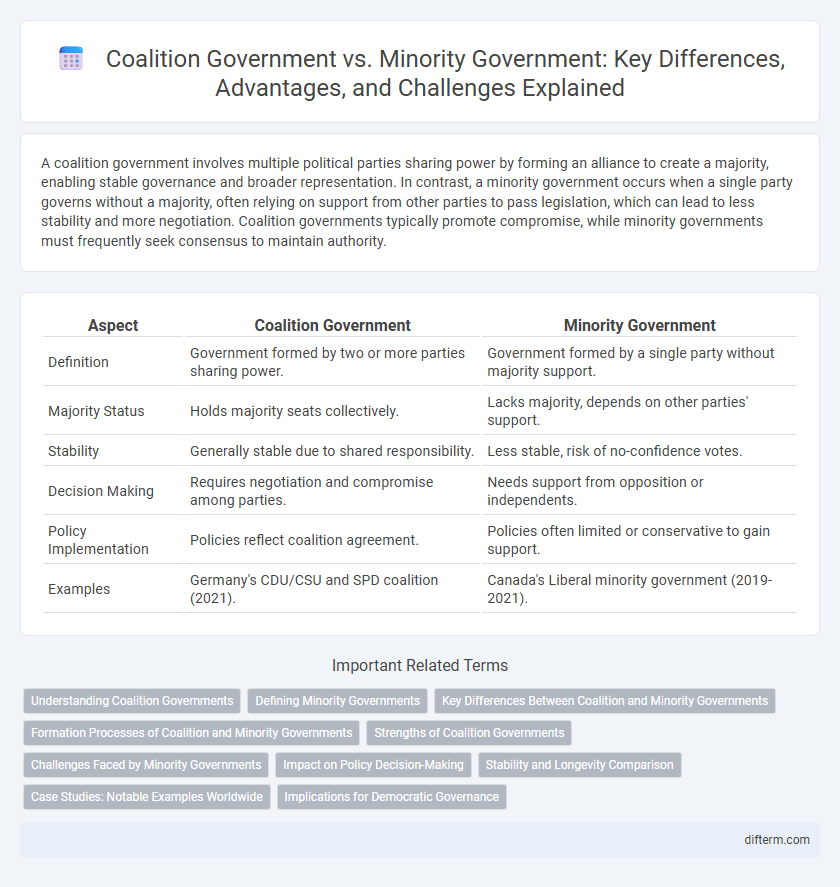A coalition government involves multiple political parties sharing power by forming an alliance to create a majority, enabling stable governance and broader representation. In contrast, a minority government occurs when a single party governs without a majority, often relying on support from other parties to pass legislation, which can lead to less stability and more negotiation. Coalition governments typically promote compromise, while minority governments must frequently seek consensus to maintain authority.
Table of Comparison
| Aspect | Coalition Government | Minority Government |
|---|---|---|
| Definition | Government formed by two or more parties sharing power. | Government formed by a single party without majority support. |
| Majority Status | Holds majority seats collectively. | Lacks majority, depends on other parties' support. |
| Stability | Generally stable due to shared responsibility. | Less stable, risk of no-confidence votes. |
| Decision Making | Requires negotiation and compromise among parties. | Needs support from opposition or independents. |
| Policy Implementation | Policies reflect coalition agreement. | Policies often limited or conservative to gain support. |
| Examples | Germany's CDU/CSU and SPD coalition (2021). | Canada's Liberal minority government (2019-2021). |
Understanding Coalition Governments
Coalition governments form when multiple political parties cooperate to establish a majority in the legislature, sharing power and policy responsibilities. These governments often arise in parliamentary systems with proportional representation, enabling diverse party representation and collaborative decision-making. Unlike minority governments, coalition governments typically ensure greater stability by combining seats to surpass the majority threshold.
Defining Minority Governments
Minority governments occur when the ruling party lacks an outright majority in the legislature, requiring collaboration with opposition parties to pass legislation. Unlike coalition governments, which are formal alliances between multiple parties sharing power, minority governments operate without a fixed partnership, relying on case-by-case support. This governance structure often leads to increased negotiation and compromise, impacting policy stability and legislative efficiency.
Key Differences Between Coalition and Minority Governments
Coalition governments involve multiple political parties sharing executive power by forming an alliance to achieve a parliamentary majority, ensuring more stable governance and collective decision-making. Minority governments, on the other hand, consist of a single party that lacks a majority in the legislature, relying on issue-by-issue support from other parties, which results in less predictable policy outcomes and increased vulnerability to votes of no confidence. The key differences lie in the level of political cooperation, legislative stability, and policy influence between coalition partners versus the independent yet precarious position of minority governments.
Formation Processes of Coalition and Minority Governments
Coalition governments form through negotiations among multiple political parties to achieve a majority in the legislature, often involving formal agreements on policy priorities and ministerial positions. Minority governments emerge when a single party governs without an overall majority, relying on ad hoc support from other parties or independents to pass legislation. The formation process of a coalition requires consensus-building and compromise, whereas minority governments depend on strategic alliances and issue-by-issue cooperation.
Strengths of Coalition Governments
Coalition governments combine the strengths of multiple political parties, enhancing representativeness and promoting broader consensus in policymaking. This collaborative approach often results in more stable governance compared to minority governments, which rely on shifting support from other parties. The pooling of diverse expertise and resources within coalition governments improves legislative efficiency and fosters compromise-driven solutions.
Challenges Faced by Minority Governments
Minority governments face significant challenges, including difficulties in passing legislation due to lack of majority support in the parliament, leading to frequent reliance on opposition parties or independents for critical votes. This instability often results in shortened government terms and increased vulnerability to votes of no confidence. Additionally, minority governments must engage in constant negotiation and compromise, which can slow decision-making processes and reduce policy effectiveness.
Impact on Policy Decision-Making
Coalition governments enhance policy decision-making by combining diverse party perspectives, resulting in more comprehensive and widely acceptable policies. Minority governments often face challenges passing legislation due to insufficient parliamentary support, leading to compromises or policy stagnation. The stability and effectiveness of policy implementation are generally higher in coalition governments compared to minority governments.
Stability and Longevity Comparison
Coalition governments generally offer greater stability and longevity by combining multiple parties' support, reducing the risk of sudden collapses compared to minority governments that rely on issue-by-issue backing. Minority governments tend to face frequent confidence challenges and policy gridlocks, resulting in shorter durations and political uncertainty. Empirical data from parliamentary democracies indicate coalitions survive an average of 3 to 4 years, whereas minority governments often last less than 2 years.
Case Studies: Notable Examples Worldwide
The 2010 UK Coalition Government between the Conservatives and Liberal Democrats demonstrated successful power-sharing in a hung parliament, leading to significant policy compromises and stability. In contrast, Canada's 2004-2006 Liberal Minority Government struggled with legislative gridlock, highlighting the challenges when coalition-building fails. New Zealand's Mixed Member Proportional (MMP) system fosters coalition governments, as seen in the 2017 coalition between Labour and New Zealand First, which enabled governance despite no single party majority.
Implications for Democratic Governance
Coalition governments, formed through alliances between multiple political parties, often enhance democratic governance by promoting inclusivity and power-sharing, which can lead to more stable policymaking and broader representation. In contrast, minority governments must rely on external support from other parties, resulting in less predictability and higher chances of legislative gridlock, potentially weakening governmental effectiveness. The choice between these models impacts political accountability, legislative efficiency, and the overall responsiveness of the government to diverse citizen interests.
Coalition Government vs Minority Government Infographic

 difterm.com
difterm.com